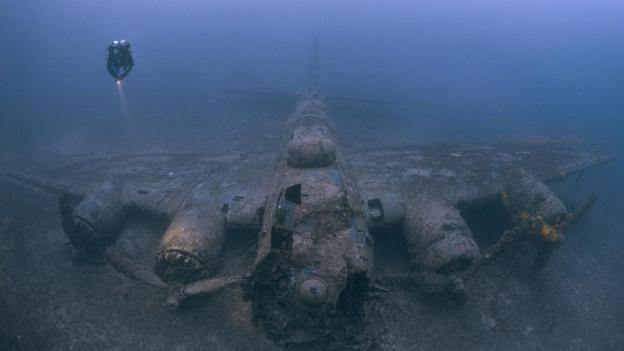
The wreck of a B-17G Flying Fortress that was hit in a bombing raid during WW2 off Vis, Croatia.
Last year, British photographer Steve Jones shot the well-preserved wreck of the World War Two US bomber B-17G Flying Fortress off the island of Vis, Croatia. The aircraft crashed in 1944 after getting hit by anti-aircraft fire, killing co-pilot, Ernest Vienneau.
“In years to come, many of the ships and aircraft lost during the World Wars will be gone forever.”
Diving such sites can be both “exhilarating and spectacular” and “sombre and sad” when there has been loss of life, says Jones; something that hit home particularly hard on this shoot.
The images Jones captured ended up having a surprisingly personal impact after he entered the photographs in the Underwater Photographer of the Year awards. His entry was published and spotted by the late co-pilot's family who got in touch with Jones.
“They had never seen images of his resting place,” says Jones. “The follow-on correspondence meant even more to me than the dive itself.”
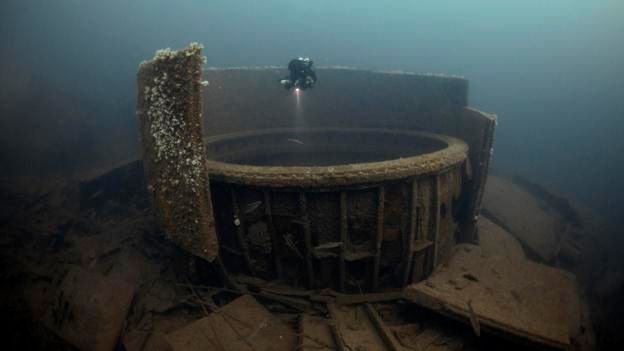
Credit: Steve Jones www.millionfish.com
British Super Dreadnought HMS Audacious was the first British Battleship lost in WW1. (Credit: Steve Jones/www.millionfish.com)
“From descending into the massive cylindrical turret armour of the WW1 Battleship HMS Audacious, to seeing the deck of the WW2 wreck SS Empire Heritage covered in Sherman tanks, I’m frequently left in awe of what I’ve seen,” he says.
Credit: Steve Jones/millionfish.com
The conning tower of the British submarine HMS Stubborn, which was scuttled in 1946 in Malta after service during WW2.
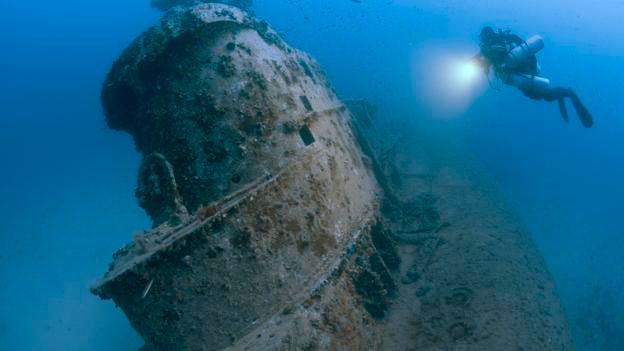
But these relics from one of the bloodiest chapters in human history are slowly disappearing.
“In years to come many of the ships and aircraft lost during the World Wars will be gone forever,” says Jones.
Since wrecks deteriorate over time, he says, photographing them is “capturing a point in history that will never be seen again”.
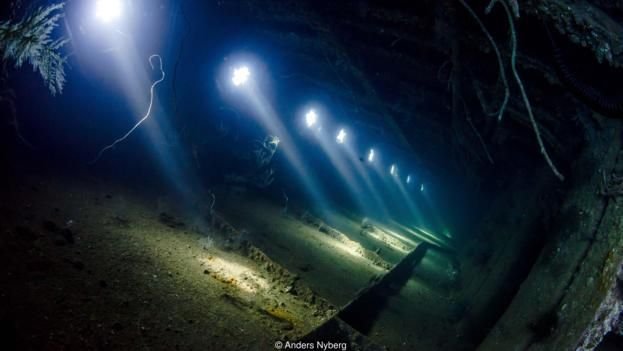
The Giannis D wreck off Egypt, in the Red Sea. Credit: Anders Nyberg
The Giannis D wreck off Egypt: "One of the most attractive backgrounds for a photo taken inside a wreck are lightbeams shining in through portholes." (Credit: Anders Nyberg)
“Underwater photography and scuba diving is a form of meditation.”
“When you dive on a wreck that has lain on the seabed, sometimes over a hundred years, it's like time stood still,” says Anders Nyberg, a freelance photographer from the Swedish island of Gotland.
His favourite technique is to showcase familiar objects in the strange, other-worldly setting of the deep.
A British WWII BSA M20 motorbike in the hold of the Thistlegorm. Credit: Anders Nyberg
A British WWII BSA M20 motorbike in the hold of the Thistlegorm, which lies off Egypt in the Red Sea. (Credit: Anders Nyberg)
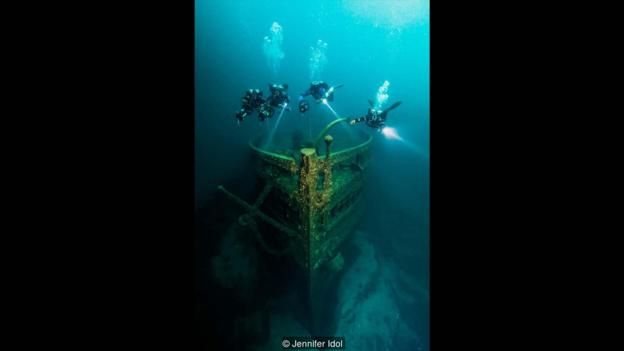
“It may be a door handle, a vase or a binocular, furniture or a wall with a tool that hangs neatly left on the wall. It is so I like it, untouched, to get the best pictures,” he says.
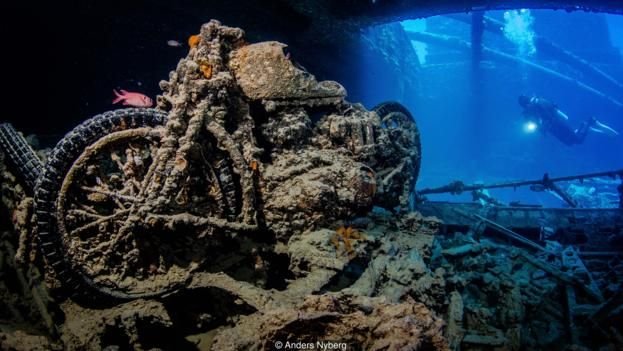
Wreck sites like the SS Thistlegorm, one of the world’s best-known wrecks, are among his favourite to photograph, as the area’s diverse marine life and beautiful corals make rich, wide-angle photography subjects.
Nyberg’s most startling experience, though, was not one he managed to capture on camera.
Credit: Anders Nyberg
The SS Hornstein was a German cargo steamer that ran aground in the Baltic Sea in 1905. (Credit: Anders Nyberg)
He and his wife were diving SS President Coolidge, which sank in 1942 off the island Esparto Santo, Vanuatu, when the cargo rooms became flooded with blue flashing lights.
“Slowly we were totally surrounded by this glitter and I became completely disorientated,” he says.
The peculiar blue lights turned out to be the biolumiscent eyes of a school of fish. The phenomenon – thought to attract or illuminate prey – can only be seen in total darkness, so turning on a torch would have stopped the effect.
Nyberg’s advice for getting the perfect underwater shot is to master your diving and camera equipment before going into the water. For safety it is important to use a line to follow out, in case visibility is poor.
Diving on wrecks is both exciting and physically and mentally demanding, but it can also be “a form of meditation, to relax from the stress of everyday life and work”.
Credit: Jennifer Idol
The USS Kittiwake in Grand Cayman served as a submarine rescue vessel before it was sunk as a diving site. (Credit: Jennifer Idol)
Photographer, designer, and author, Jennifer Idol is the first woman to dive 50 states in her native US.
“I particularly enjoy large intact wrecks that are historic and not artificial reefs. Each wreck tells a story,” Idol says.
Wreck diving etiquette
Respect War Graves
Treat wrecks with the respect you would give a churchyard.Respect the Wreck Environment
Treat them with the care you would give to coral reefs.Respect the Future
Take photos rather than souvenirs.Respect Our History
If you find anything, report it to the Receiver of Wreck.Respect Yourself
Make sure that you are appropriately trained for safe wreck diving.Respect Your Family and Friends
Some wrecks contain dangerous cargoes or live munitions – don't disturb them.Respect the Law
Know and respect maritime laws – and avoid a criminal record.
Source: British Sub-Aqua Club
She describes her experience photographing the U-352 in North Carolina – a WW2 German submarine sunk by the US Coast Guard Cutter Icarus, which rests at 35m (115 feet) below the surface.
“It feels like descending through time until you reach a boat much smaller than you expect.”
To take successful photographs, Idol advises focusing on recognisable features of the wreck.
“Wrecks easily appear abstract and unidentifiable.”
“Wrecks easily appear abstract and unidentifiable,” she explains.
“The bow and stern are obvious exterior shots while a conning tower, wheelhouse, or unique feature to a wreck will work on the interior. Using models in an image helps show the scale of a wreck.”
Credit: Jennifer Idol
"Wrecks like the USS Kittiwake can require panoramic treatment to showcase their entirety," - Jennifer Idol. (Credit: Jennifer Idol)
Creating a powerful image takes planning. Idol says it is important photographers consider “orientation, condition, and depth” before a shoot.
“A ship can be too large to see on one dive, especially when setting up a photo. Usually, descent lines are set in place or boats are moored to a line from which you follow to the wreck.
Credit: Jennifer Idol
The Eber Ward lying in the straits of Mackinac, US,was a wooden bulk and package freighter that struck ice in 1909. (Credit: Jennifer Idol)
“If you are creating images inside the wreck, it is important to first become familiar with the wreck and then also to follow necessary diving procedures for penetration. This may include setting lines or diving mixed gases and using redundant diving systems.”
Even to someone as experienced as Idol, wrecks can yield surprises.
“I am sometimes surprised to find schools of fish, invertebrates, and even eels deep inside wrecks,” she says. “The life inside a wreck is surprising because it feels remote, is dark, and evades currents.”
Credit: Jordi Benitez
The Dragonera off Tarragona, Spain was sunk in the 1990s as an underwater tourism attraction. (Credit: Jordi Benitez)
“It is very nice…to see how the sea makes from a huge piece of steel a new house for fishes”
“It’s very special to feel you are in a place where some years ago there was people cruising the seas on it. I can imagine a lot of stories about it,” says Jordi Benitez, a banker from Spain who started in underwater photography 12 years ago.
“It is very nice too, to see how the sea makes from a huge piece of steel a new house for fishes, and how a new ecosystem is created around the wreck.”
Benitez’ subjects have included the Dragonera in Tarragona – a large ship sunk in the 1990s as an underwater tourism attraction – and in the Red Sea the Chrisoula K and Thistlegorm. The former is a cargo ship that struck a reef and sank in the 1980s, and the latter a British wartime ship that was attacked and sunk in 1941, killing nine people. The Thistlegorm wreck was discovered in the 1950s.
Credit: Jordi Benitez
Chrisoula K in the Red Sea was a cargo ship that sunk after striking a coral reef. (Credit: Jordi Benitez)
“I love to dive in the SS Thistlegorm because there are still a lot of materials from WW2,” says Benitez. “You can see bikes, trucks, trains, wings of planes... You feel as [though] you were travelling 70 years back.”
His advice for capturing effective underwater photographs is to use a “very wide-angle lens” and to “play with the light”.
“In underwater photography, we use many times strobes and artificial light, but in wrecks, it’s very nice to play with natural light, this gives also a special atmosphere to the pictures.”
Hi! I am a robot. I just upvoted you! I found similar content that readers might be interested in:
http://www.bbc.com/earth/story/20170404-divers-mesmerising-images-of-wrecks
Downvoting a post can decrease pending rewards and make it less visible. Common reasons:
Submit
Nice Post..
Don't forget follow and upvote my blog
Downvoting a post can decrease pending rewards and make it less visible. Common reasons:
Submit